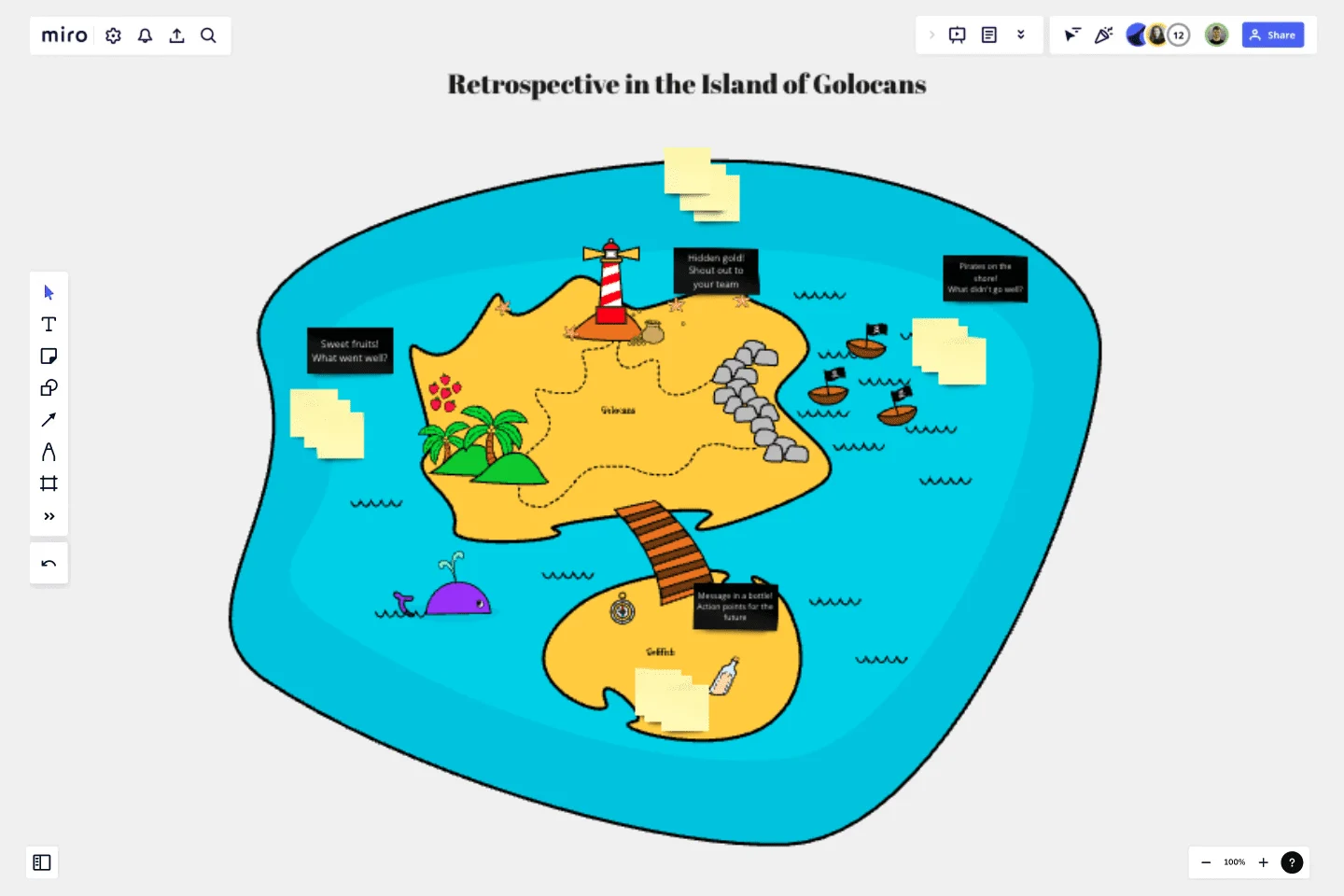Retrospective in the Island of Golocans
The Island of Golocans has four very unique characteristics. Run a effective retrospective with it.
The Island of Golocans has four very unique characteristics. The West has an abundance of sweet fruits, green hills and plenty of trees for some shade during peak summer. Apparently, the North of this island has some hidden gold coins near a lighthouse. In this region, one might spot plenty of starfish, too. The East coast is notorious for invading pirates - not all of them make it through the rough seas, though. The few that make it have to then climb up very uncomfortable rocks and only then will they be able to enter this island. Finally, the South Island, which is also known as Golifish, is connected with a wooden bridge. This region is very popular with voyagers who often come here and leave notes in glass bottles for future readers. They often also leave items of significance, like a compass, for guiding their journey to this island.
When performing a retrospective on the Island of Golocans, remember to cover all four directions:
Sweet fruits! What went well during the last sprint? Add a post-it note with your thoughts and celebrate your wins.
Hidden gold! Give your team a shout-out for the amazing work they've been putting in, the nuggets of information they provide, and for just being an awesome person to work with.
Pirates on the shore! This doesn't sound good, does it? Recall what didn't go well in the last sprint and write them down on each post-it note.
Message in a bottle! Record action points for the future. If you've thought of actionable items you and your teammates could work on to ensure that things can be better in the next sprint, make a note of them. If you have general ideas that can be implemented in the next sprint, make a note of them, too!
Have a pleasant time exploring this island!
This template was created by Clyde D'Souza
Explore all Miro's tool for online retrospectives and run more engaging and inclusive retros.
Get started with this template right now.
Stakeholder Mapping Template
Works best for:
Business Management, Mapping, Workflows
A stakeholder map is a type of analysis that allows you to group people by their power and interest. Use this template to organize all of the people who have an interest in your product, project, or idea in a single visual space. This allows you to easily see who can influence your project, and how each person is related to the other. Widely used in project management, stakeholder mapping is typically performed at the beginning of a project. Doing stakeholder mapping early on will help prevent miscommunication, ensure all groups are aligned on the objectives and set expectations about outcomes and results.
Lean Inception Workshop
Works best for:
Agile, Lean Methodology
The Lean Inception Workshop streamlines project kickoff by aligning teams on goals, scope, and priorities. It leverages Lean principles to eliminate waste and maximize value, guiding exercises to define user personas, map user journeys, and prioritize features. By fostering cross-functional collaboration and customer-centric thinking, this template accelerates project initiation and ensures alignment between stakeholders, empowering teams to deliver customer value faster.
The Lightning Product Audit
Works best for:
Product Management, Planning
The Lightning Product Audit template streamlines product evaluation processes with a comprehensive framework. By assessing key areas such as market fit, user experience, and feature performance, this template enables teams to identify strengths, weaknesses, and areas for improvement swiftly. With sections for conducting SWOT analysis, user feedback review, and competitive benchmarking, it facilitates data-driven decision-making and prioritization. This template serves as a catalyst for refining product strategies and driving continuous improvement.
Team Charter Template
Works best for:
Meetings, Workshops, Team Meetings
A team charter is a document that outlines your team’s purpose and objectives, as well as steps you will take to reach your goals. The team charter illustrates the focus and direction for all team members. When created collaboratively, the team charter is a great way for individuals to feel even more connected to one another within the group. A team charter template is useful when you’re first establishing a new team, adding new members to an existing team, or when you need to better align regardless of your team’s tenure.
Sailboat Template
Works best for:
Agile Methodology, Meetings, Retrospectives
The Sailboat Retrospective is a low-pressure way for teams to reflect on how they handled a project. By defining your risks (the rocks), delaying issues (anchors), helping teams (wind), and the goal (land), you’ll be able to work out what you’re doing well and what you need to improve on for the next sprint. Approaching team dynamics with a sailboat metaphor helps everyone describe where they want to go together by figuring out what slows them down and what helps them reach their future goals.
Iceberg Reflection
Works best for:
Agile
The Iceberg Reflection template is a visual tool for facilitating reflective exercises within Agile teams. It prompts participants to explore both visible and underlying aspects of challenges or successes, akin to an iceberg where only a portion is visible above the waterline. This template encourages deeper reflection and insights, fostering a culture of continuous improvement and learning. By addressing root causes and hidden factors, teams can better understand and overcome obstacles, driving growth and resilience.
